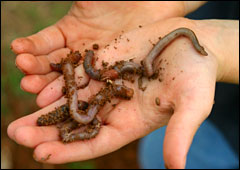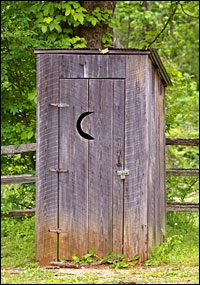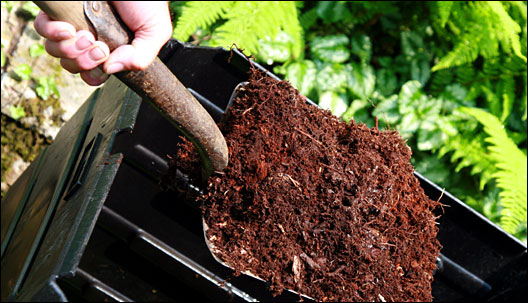
Composting is a lot like sex. It’s a healthy, natural process involving fertility, tumbling around, and — when it’s going right — steaminess. On top of that, some people call it dirty.
It’s not our fault we’re squeamish. Most Americans are praised from an early age for taking out the garbage — not hoarding it and keeping scraps of it in our kitchens. Toss in the false mythology that composting is complicated, smelly, and wormy, and it’s understandable that we’ve wrinkled our collective noses at it.
But no longer. Today, growing legions of converts are hot to rot, from celebs like Julia Roberts and Pierce Brosnan to heaps of urbanites, suburbanites, and local governments.
Modern composting is easy, odor-free, and ultra-earth-friendly, providing rich, fertile soil that retains water and needs no nasty fertilizers or pesticides. The process — in which microorganisms munch organic materials and break them down into dark, nutrient-rich humus (which should not be confused with ground chickpeas and will not taste good with pita bread) — actually helps reduce global warming, since it slashes the CO2 and methane gases released when organic waste sits neglected in landfills. And the rewards are robust plants, fruits, and veggies — a bountiful harvest indeed.
Here’s how to start digging in.

Don’t leaf all this organic goodness in your garbage!
Level One: The Baby Steps
Take a load off. The average American throws away more than 4 pounds of trash every day, up to half of which is compostable; New Yorkers alone toss enough garbage each day to fill the Empire State Building, according to the Clean Air Council. Time to stop trashing and start treasuring. For food waste, use a dishwasher-safe ceramic composting crock pot or other small vessel to collect scraps right on your kitchen counter. Toss in just about everything that isn’t dairy, meat, fish, or oils and fats. Collect yard waste in bins or bags, whatever your town prefers.
Kick it to the curb. In some places, the next step is as easy as walking to the curb. In San Francisco, for example, residents can put compost out in green bins for weekly pick-up. New York City, for its part, offers a downloadable “Worms in the Green Apple” [PDF] guide to public composting sites that welcome your waste. Other towns have composting projects at community gardens. To find a dump spot near you, call city hall or your local recycling center, or check out the online state listings at BioCycle magazine.
Level Two: The Next Steps
Manage your microbes, mini-style. No matter how small your digs might be, all that’s needed to start your own compost system are nitrogen-rich “greens” (veggie and fruit scraps, coffee grounds, green plants, etc.) and carbon-rich “browns”: dead flowers, leaves, twigs, and such. Even cramped urban dwellers can go compostal: Just collect those greens and browns in a container on your deck, balcony, or other outdoor spot. You can buy small composting bins online or, if you’re on a modest budget, snag one of the reduced-price bins offered by dozens of cities, from Seattle and Santa Cruz to Anoka, Minn. Better yet, make your own bin.
Expand your operations. Got more space and bigger composting goals? Buy one of the larger composting containers — they come in tumblers or pyramid and beehive shapes, among others — and start piling in the scraps. Another option: Make a DIY wire enclosure or, if anarchy is more your style, just start a heap in a dry, shady part of the yard. Keep your compost moist (not soggy) and give it air every week or so by turning it with a pitchfork. And to make sure your pile heats up (which means things are rotting properly), check out the simple do’s and don’t’s offered in online guides [PDF] or at your local gardening store.

Gotta hand it to ’em: those worms do wonders.
Veni, vidi, vermi. Vermicomposting — in which worms speed up the compost process — is another way to turn waste into wondrous topsoil. Red wigglers, the most common compost squigglers, live happily in small indoor bins that you can make yourself and plop in your basement or, for apartment-dwellers, under the sink. (Worms need moist, cool, dark digs in temperatures between 40 and 80 degrees Fahrenheit, so keep them outside only in moderate climes, and don’t let them roast in regular outdoor compost piles, which can reach 145 degrees or more.) Purchase composting worms online or try harvesting some night crawlers from your own backyard. Stuck on the yuck factor? Watch a vermicompost video to see how worthy worms can be.

Don’t waste another minute — start composting now.
Level Three: The Big Step
Give a shit. Of all the leaps that eco-warriors are taking, embracing the humanure, um, movement, is one of the bravest. Fecal matter, as we all know, carries lethal diseases, stench, and the worst image problem on earth. But today those prejudices are getting flushed. Modern composting toilets, from the basic to the swanky, provide odor-free sanitary systems that morph human waste into safe and compacted compost — without ugly visuals or other eww factors. Excretions go into a compartment where they break down into compost that can be buried in the yard, garden, or landscape. Since the units don’t require water or electricity — and don’t need energy-and-chemical-laden waste treatment processes — the environmental benefits are enormous. (Consider: About 40 percent of America’s indoor water use goes to flushing toilets, wasting more than 4 billion gallons of H2O a day.)
Composting privies are perfect for remote or arid landscapes; eco-conscious homeowners are trying them, too. To make sure they’re legal in your state, check with your local public health department or consult The Humanure Handbook. Install one, and you’ll have unbeatable greenness — just a throne’s stow away.
Resources
General composting information, tips, and advice
How to Compost.org
Compost Guide
Green Culture
Environmental Protection Agency
YouGrowGirl
Composting supplies
Gardener’s Supply Co.
GreenCulture
NatureMill
Greenfeet
Guides to neighborhood and community composting
BioCycle magazine
EPA guide to composting programs
Wormy goodness
City Farmer
Freshtopia
Earthworm Digest
Worm Woman
Composting toilets
Sun-Mar
Oikos
EPA fact sheet [PDF]
The Humanure Handbook


